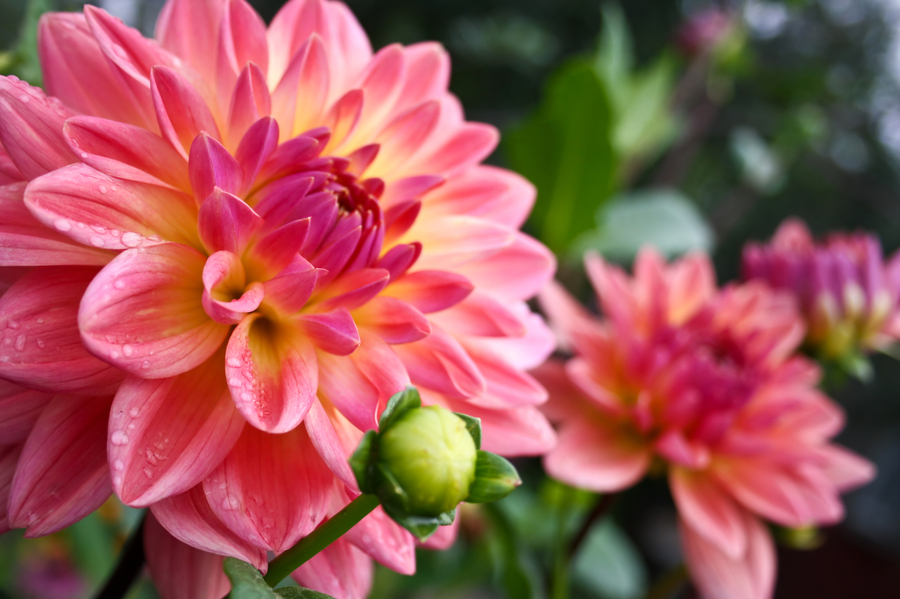Dahlias (Dahlia spp.) are stunning herbaceous perennials that boast an array of flower colors, shapes, and sizes. They bloom in mid-summer to late fall and light up the garden borders.
With their vibrantly colored flowers and sizes, dahlias brighten every garden style and theme. They look great from tropical to exotic, and cottage-style garden borders and as mass container plantings for patios and balconies.
This guide will cover all information on how to grow dahlias from tubers and seeds, including advice on best care practices for them (like choosing the best fertilizer for dahlias) as indoor and outdoor garden plants.
Note: These summer garden darlings (Dahlia spp.) are not frost-hardy and need overwintering. Therefore, they are grown as decorative annuals in the USDA hardiness zone 6 and below.
All About Dahlias
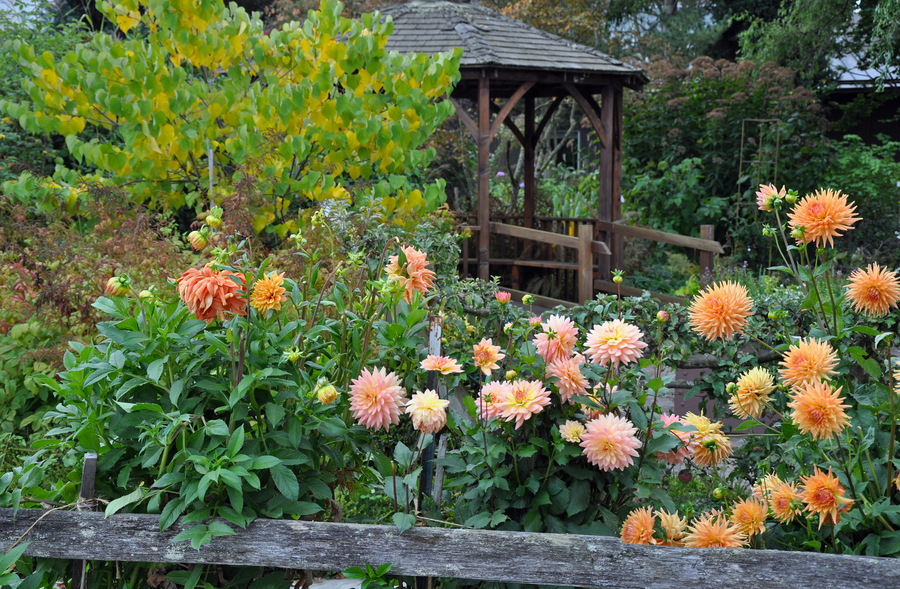
Dahlias are magnificent perennials that decorate summer gardens and floral displays because of their flowers. Their flowers come in a variety of colors, shapes, and sizes. The bloom colors range from white, yellow, orange, and pink to bright pink, dark red, purple, black, and variegated types. While the dahlia flower shapes and sizes vary from tiny 2-inch compact ball flowers to giant 15-inch dinner plates.
They are native to Mexico and are members of the Asteraceae family. These flowering perennials make stunning cut flowers and brilliant border plants when planted with cosmos, grasses, and cannas.
Dahlias are primarily grown through tubers that can be planted in gardens after the frost. They are fast growers and reach a mature height of 1 to 3 feet in a single growing season.
Are Dahlias Perennials or Annuals?
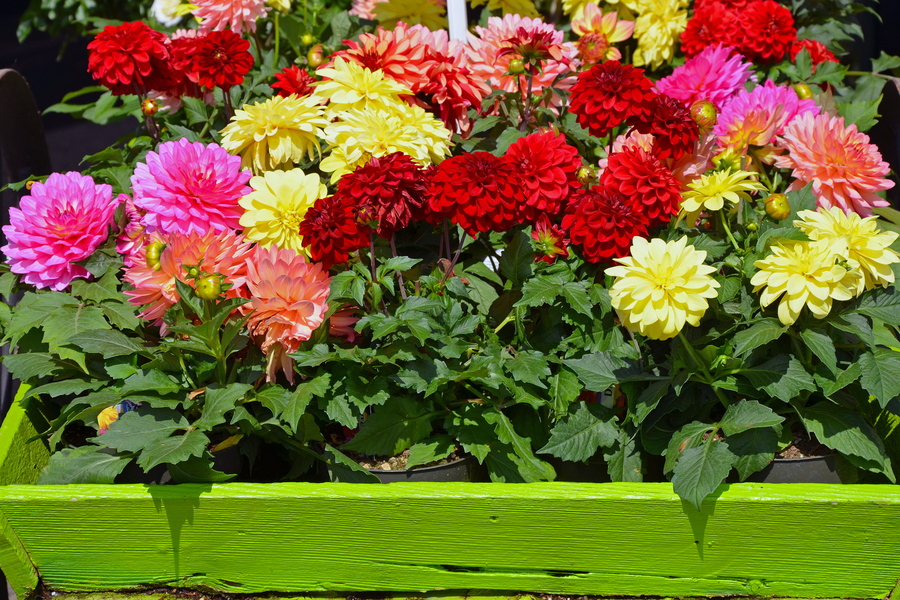
Within their native regions, North America and Central America, dahlias are herbaceous perennials that continue to thrive and bloom year after year. However, these showstoppers are grown as annual flowering plants in colder areas (USDA hardiness zones seven and below).
In these regions, gardeners plant them in late May to early June to gardens and dig up the tubers in the last week of September for use in the following year.
Quick Care and Planting Guide of Dahlia Flowers
| Common name | Dahlia, Bedding Dahlia |
| Botanical name | Dahlia spp. |
| Family | Asteraceae |
| Plant type | Herbaceous perennial, bulb |
| Mature plant size | 1-6 feet tall and 1-3 feet wide |
| Growth rate | Fast |
| Growth habit | Upright |
| Maintenance | High |
| USDA hardiness zone | 7a, 7b, 8a, 8b, 9a, 9b, 10a, 10b |
| Native Region | North America, Central America |
| Propagation | Root cutting, division, seed |
| Propagation time | May |
| Sunlight | Full sun (more than 6 hours of direct sunlight daily) |
| Soil | Moist, well-draining, and high organic matter soil |
| Water | Water only once a week during the growing season (spring and summer) |
| Temperature | 65-80 degrees Fahrenheit |
| Fertilizer | Fertilize dahlias with a high percentage of phosphorus (10-30-20 ratio) |
| Planting time | May, June |
| Pruning or pinching back | November |
| Bloom time | Summer, fall (July, August, September, October) |
| Flower color | Cream/tan, gold/yellow, black, pink, orange, variegated, white |
| Unique plant attributes | Attract butterflies and hummingbirds, and make brilliant cut flowers in floral arrangements |
| Landscape and garden uses | Container and mass plantings, accent plants in garden borders, understory plants in large trees or backdrop in low-growing perennials |
| Common insect pests | Slugs and snails, earwigs, caterpillars, leafhoppers, aphids, whiteflies |
| Plant diseases | Powdery mildew, root rot, crown gall, Fusarium wilt |
| Toxicity | Toxic to cats and dogs |
How to Grow Dahlias
Dahlias are easy to grow – they thrive in moist, well-drained soils, sheltered and full-sun locations. With their rapid growth rate and erect growth habit, dahlias brighten every garden corner throughout the summer. They are hardy in the USDA hardiness zone 7-10 and attract pollinators and hummingbirds with large, colorful leaves.
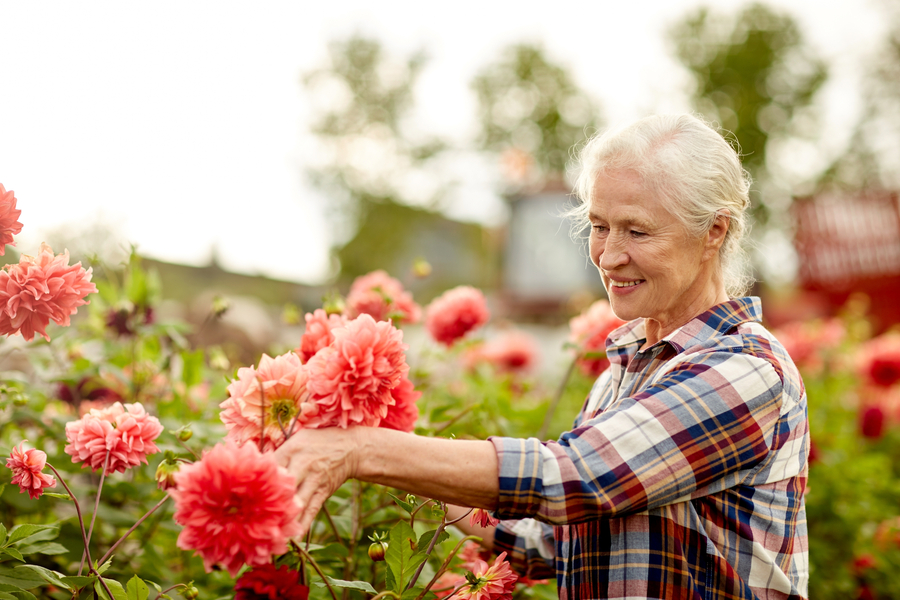
The best time to plant them is in late April or early May when the soil temperatures exceed 60 degrees Fahrenheit. Otherwise, the dahlia tubers will not sprout in cold soil.
Follow these dahlia planting tips to know how to grow dahlias successfully and enjoy showy blooms from mid-summer to fall:
Preparing the Site for Dahlia Planting
One of the crucial steps in dahlia bulb care and planting is an ideal garden spot with super healthy soil. Follow these steps to achieve a well-prepared garden site for showy dahlias because, in healthy soil, they will multiply and produce beautiful flowers.
- If your garden soil is heavy or clayey and compact, it is crucial to amend its texture and drainage for successful growth and blooming. Mix the soil with organic material (shredded leaves), worm castings, and grit to improve nutrition and drainage. Also, you can mix a handful of fertilizer for dahlias, such as Miracle-Gro All Purpose Plant Feed. Ensure to mix this fertilizer thoroughly with soil and distribute it evenly. In addition, applications of a bone meal also serve as the best fertilizer for dahlias, which slowly release nutrients into the ground.
- Planting dahlia tubers on raised beds is best if you live in an area of heavy rainfall.
When to Plant Dahlias
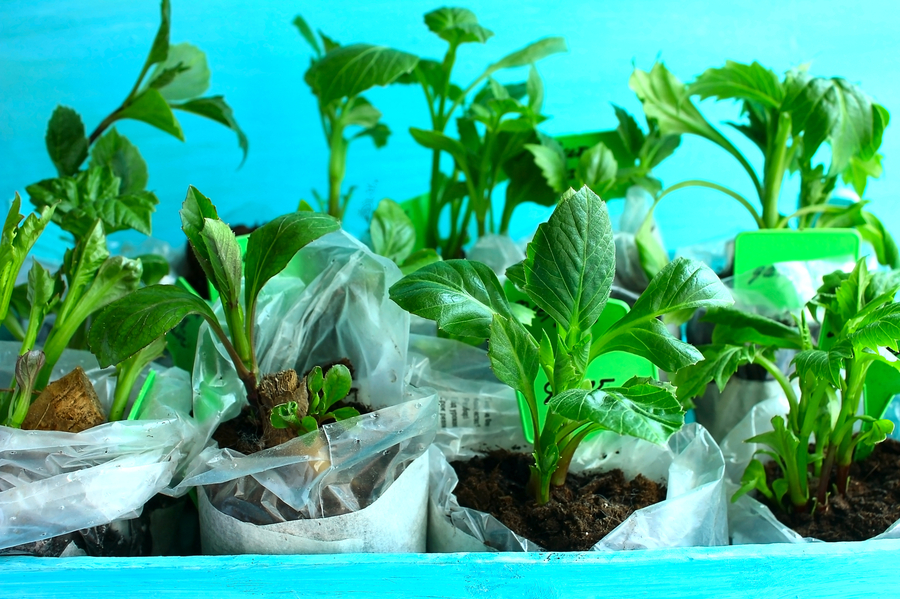
These fast growers are hardy in the USDA hardiness zone 7 to 10 and can be planted mid to late spring outdoors. You can also grow dahlias in zone 5 and 6. However, in colder climates, the best way on how to plant dahlias is to start them indoors in containers at least 6 to 8 weeks before the last frost date.
Plant the tubers in one-gallon containers filled with soilless potting mix and position them in a warm, sheltered place.
Wait until you observe the new growths or shoots emerges from growing points or eyes. Once the seedling development is about 5 to 7 inches tall, transplant them outdoors. Ensure the soil temperature is warm enough and that the plants get a lot of sun.
How to Grow Dahlias from Tubers
- Dahlias can be started outside in gardens in mid to late May when all the risks of spring frost have passed. Before planting, examine the tubers for rots and remove some shoots to promote bushier growth and enormous flowers.
- Now harden off or acclimatize these tubers to outdoor conditions before planting in the garden. Simply put them outdoors during the day and bring them back indoors at night. Repeat this practice for one or two weeks.
- Dig planting holes in prepared garden sites, which should be 12 inches deep and wide. Add a container of well-rotten manure or worm castings into the hole for soil fertility. This organic material will function as the best fertilizer for dahlias and speed up sprouting.
- Set the tubers into the holes as growing tips or eyes facing up with a distance of 3 feet in larger varieties and 1-2 feet in smaller ones.
- Cover the tuber crown with a thin layer of soil. Avoid watering and mulching after planting the tubers because they need full sun for shoot development.
- Once the tubers have been grown outdoors, use garden stakes or bamboo canes to support larger varieties and tie the new growths onto stakes.
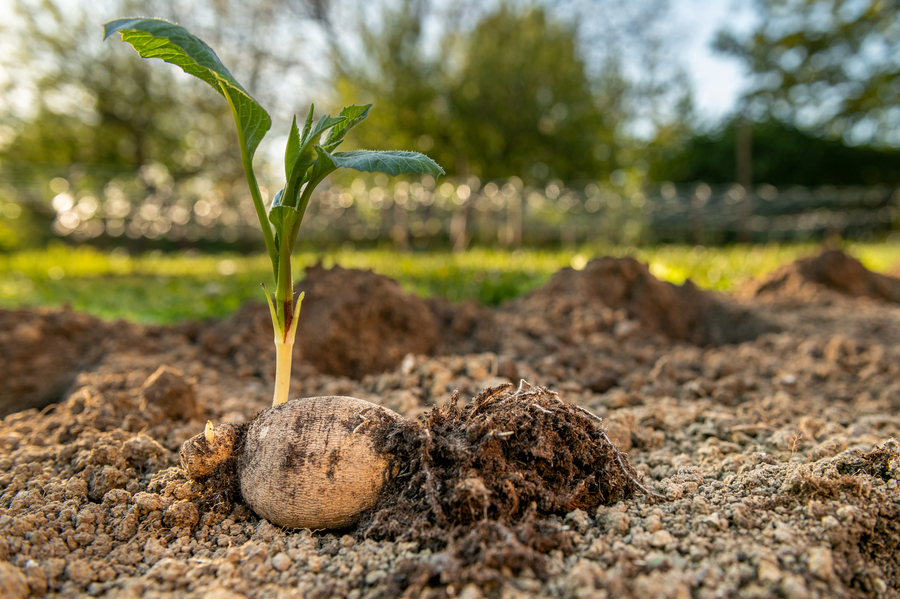
How to Grow Dahlias from Seed
Dahlias can be grown from seeds harvested from the last year’s blooms. Follow the steps below to know how to grow dahlias, specifically, tubers from seeds:
- Fill the seed starter tray with moist and well-draining potting mix.
- Sow the seeds in a seed starter tray five to six weeks before the frost date and situate it in a south-facing window.
- Examine the trays daily for soil moisture and seed sprouting. Once the seeds have germinated, allow the young to produce true leaves.
- Once the seedlings are about 8 inches tall with 3 to 4 young leaves, transplant each healthy plant outdoors or in a large container. Remember to grow only dwarf dahlia varieties in containers while taller outdoors when the soil temperatures exceed 65 degrees Fahrenheit.
Note: Taking care of dahlias is easy as these fast growers are not picky about their growth conditions except for warm soil temperatures and regular fertilization. They can quickly grow in rich, fertile, and well-draining soil.
How to Plant Dahlias in Zone 5
Fill a one or 2-gallon pot with moist and well-draining potting mix and plant the tubers as sprouts facing up.
Cover the tuber with 2 inches of soil and situate the container in a warm and well-lit place. Once the shoots are 5 to 6 inches tall, give the dahlia tubers their first watering.
How to Plant Dahlias in Zone 6
Follow the same directions outlined above but plant the tubers of bushier cultivars about 18 to 36 inches apart for better air circulation.
Frequently Asked Questions (FAQ) on How to Grow Dahlias
Do dahlias need full sun?
Yes, dahlias need full sun for fuller growth and development in colder regions. Select a garden site with full sun exposure, particularly the morning sunlight with afternoon shade.
So a south, west, or east-facing garden border is best for these fast growers.
Are dahlias sun or shade flowers?
Dahlias are sun-loving flowers. Direct sunlight of 8 to 9 hours is crucial for their healthy growth and development.
However, there is an exception to this rule, especially in warmer regions with temperatures above 100 degrees Fahrenheit. Plant them in partial shade with morning sun and afternoon shade.
How long does it take for dahlia tubers to sprout?
The sprouting time depends on the USDA hardiness zone and weather conditions. Dahlias proliferate quickly in fertile and warm soil temperatures, such as within three weeks of growing. But in cold and heavy soils, these fast growers take longer to produce shoots.
When do dahlias sprout?
When planted in early spring, dahlia tubers develop nodes within 2 to 3 weeks. Ensure the soil is rich, moist, and well-draining.
How long does it take for dahlias to bloom?
Dahlias bloom about eight weeks after planting when adequately fed with balanced fertilizers. When grown in early May, dahlias start flower bud production in July and display exquisite blooms.
What time of year do dahlias bloom?
Magnificent dahlias bloom from midsummer through the late fall and show a range of flower colors, shapes, and sizes.
What to do if my dahlias are not blooming?
These are the top reasons that your dahlias are not blooming:
1. Poor soil drainage
2. Water stress (overwatering and underwatering)
3. Overfeeding with nutrients such as high-nitrogen fertilizers
Do you water dahlias after planting?
Do not water dahlias after planting; wait until the sprouts appear above the soil. This way, the tuber will develop its root system and start living off soil nutrients and moisture while sending out shoots. Once the sprouts are 4 to 5 inches tall, water them to prevent tuber drying.
What to feed dahlias?
These herbaceous perennials are heavy feeders, performing best in nutrient-rich soils. So fertilize them with phosphorus-rich plant food every two weeks for fuller growth and best blooms.
Avoid the application of nitrogen-rich fertilizers because they weaken the underground tubers and promote more foliage growth. So the best fertilizer for dahlia is bone meal, wood ash, and banana peels.
When do you plant dahlias in zone 5?
In USDA hardiness zone 5 and colder regions, start the tubers indoors 4 to 6 weeks before the last spring frost date in containers.
When do you plant dahlias in zone 6?
The best time to start dahlias in USDA hardiness zone 6 is mid-May when all the danger of frost has passed.
How to Take Care of Dahlias
Bedding dahlias are easy to grow and care for, whether in annual flower beds or containers. They thrive in fertile soil, warm temperatures, and full sun of 6-8 hours daily. When grown outdoors, the best practice is to plant them in wind-protected spots.
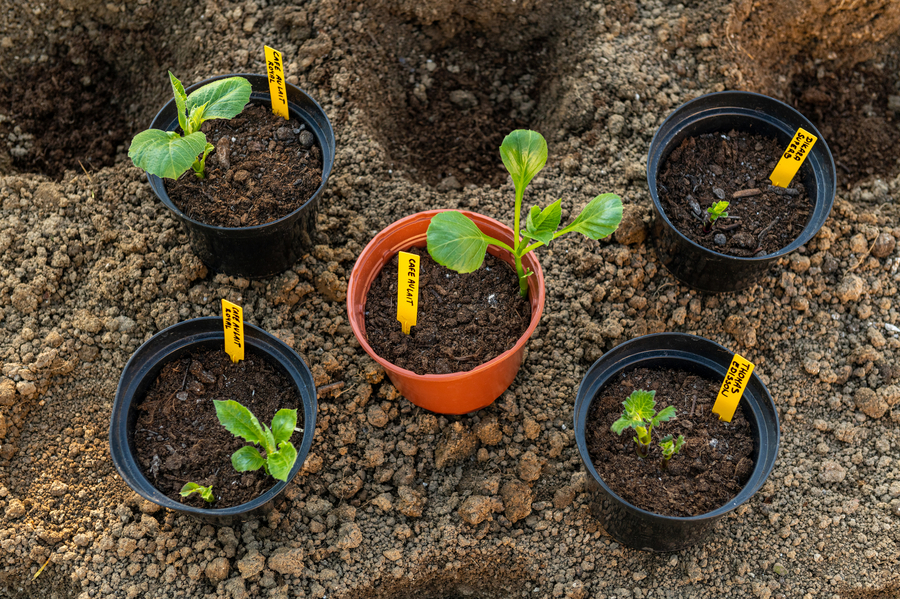
Stake the taller varieties to prevent falling onto the ground. When these tender perennials are adequately cared for and maintained, dahlias deliver big, brightly colored blooms for months. Follow the dahlia planting tips below for the best dahlia growth from spring to late fall. These tips are also helpful for potted dahlia care.
Water
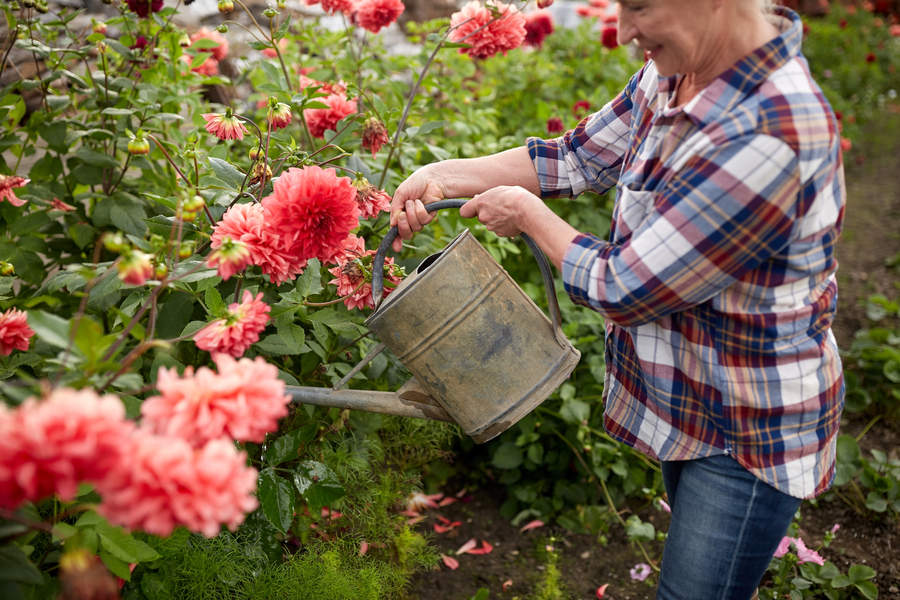
Dahlias need consistent watering throughout the growing season (the more hydrated the root system, the bigger the blooms). So, water them every week or twice a week once the dahlia tuber has sprouted. Use a soaker hose or drip irrigation system to water young dahlias because they will direct the moisture to the root zone and profoundly hydrate the larger tubers six inches deep into the ground.
During hot summer weather, use mulching around the plant base to conserve moisture and discourage weed growth. If you are not using mulch, water them more frequently (two to three times per week) to avoid soil drying. Similarly, container-grown dahlias require regular watering through spring, summer, and fall for thriving and blooming.
Important Tip: Avoid hand watering in young dahlias to prevent the foliage from wetting. Otherwise, these damp leaf surfaces will favor the growth of rotting fungal and bacterial pathogens.
Dahlia Sun Requirements
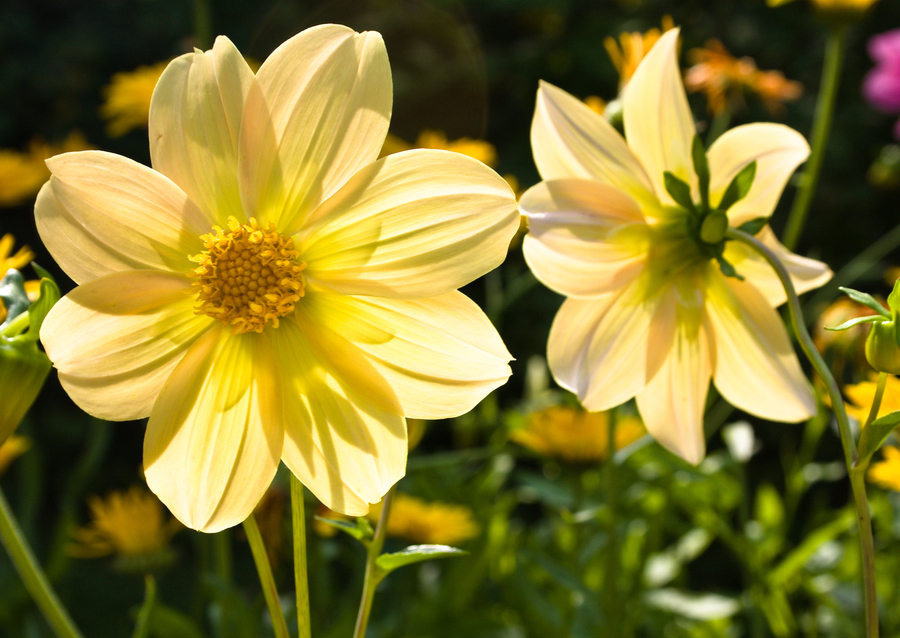
The sun is one of the most vital elements in learning how to take care of dahlias. Dahlias grow best in full sun for the best vegetative and reproductive growth. So plant them in a sunny garden spot for direct sun exposure. Proper potted dahlia care shows that indoor potted dahlias thrive best in south, west, and east-facing windows.
These herbaceous perennials need direct sunlight for 8 hours to flourish and bloom prolifically.
Soil
Stunning dahlias thrive in moist, nutrient-rich, and well-draining soil. The garden soil with sandy loam texture and neutral pH levels are perfect for these mid-summer bloomers.
Mix equal parts of compost or worm castings, sand, peat moss, and animal manure to make the soil nutrient-rich and loamy texture. Adding these ingredients to your garden soil will improve its texture and drainage.
Temperature and Humidity
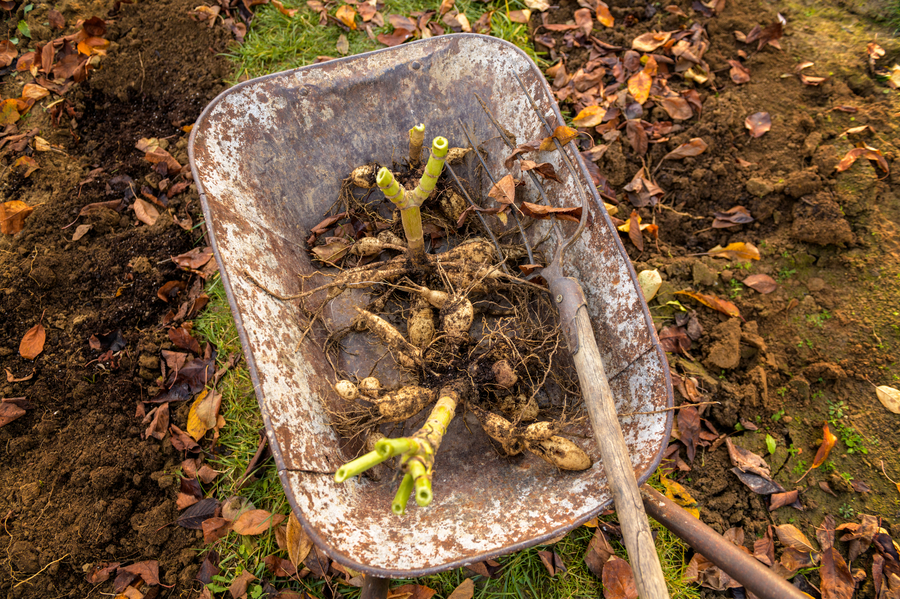
Dahlias grow best in warm soils, so plant the tubers only when temperatures exceed 60 degrees Fahrenheit. For this, you can start tubers indoors in containers and then transplant the seedlings to gardens when all the danger of spring frost has passed.
Also, the best way is to wait for dahlia tuber planting until the last date of spring frost.
For dahlia tuber storage purposes, wrap them in paper bags and store them in areas with moderate humidity. Otherwise, the tubers will shrivel and dry out.
Growing Dahlias in Partial Shade
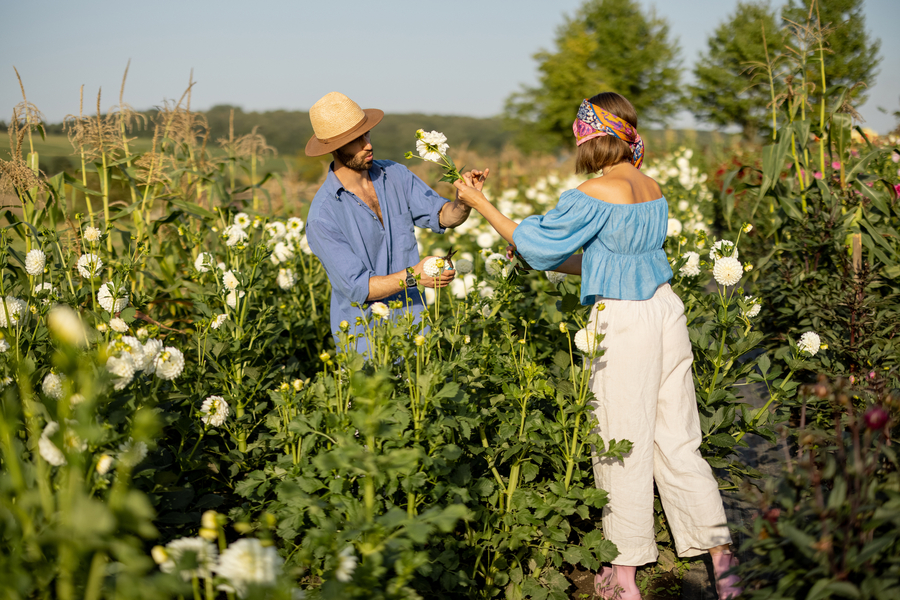
Dahlias are late-season bloomers, meaning the full sun is the prerequisite for abundant flowering. However, these beautiful plants need partial shade or protection from the afternoon sun in warmer regions (USDA hardiness zone below nine or where the temperature remains above 100°F during summer).
On the other hand, in colder climates, they can survive the afternoon sun without damage to the foliage and root system.
Dahlia Fertilizer Requirements
Dahlias bloom vigorously throughout the growing season. Therefore, they need continuous applications of heavy fertilizers with higher phosphorus concentrations. Also, the more fertilizer the plant receives, the larger they grow with more prominent blooms.
How to Fertilize Dahlias
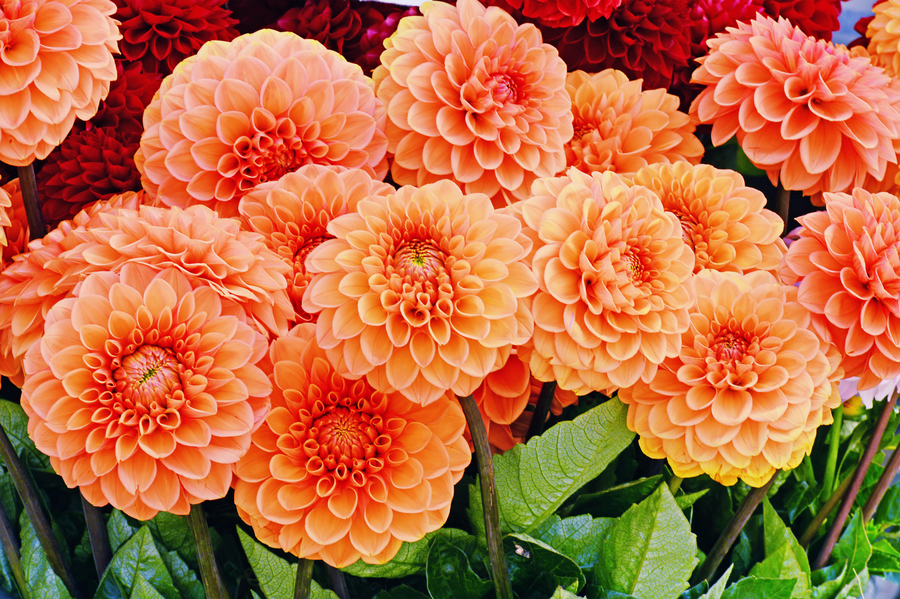
The best practice is to cover the soil with a 3-4 inches layer of well-rotted animal manure or compost and then dig into the ground for decomposition and nutrient release.
After this, apply a general-purpose dahlia fertilizer 5-10-10 at planting time to provide balanced nutrients. Then, follow with a phosphorus-rich fertilizer such as tomato feed every three weeks from midsummer to fall. These regular applications will encourage more blooms.
While for the container-grown dahlias, feed them every week with a balanced fertilizer. Ensure not to overfertilize the plants with nitrogen-rich feed because it will weaken the tubers and promote more remarkable foliage growth.
When to Fertilize Dahlias
Fertilizing dahlias after 30 days of planting when grown and maintained in nutrient-rich ground is best as it determines the strength of tubers to thrive and bloom in the long season. Also, use granular or liquid plant food for the best application and feeding.
Note: Once the dahlia plant completes its blooming cycle, dig up and store the tubers for winter. For this purpose, stop feeding your dahlia plant in late August to discourage new growth and store energy in tubers for the following year.
What to do if Dahlias are not Blooming
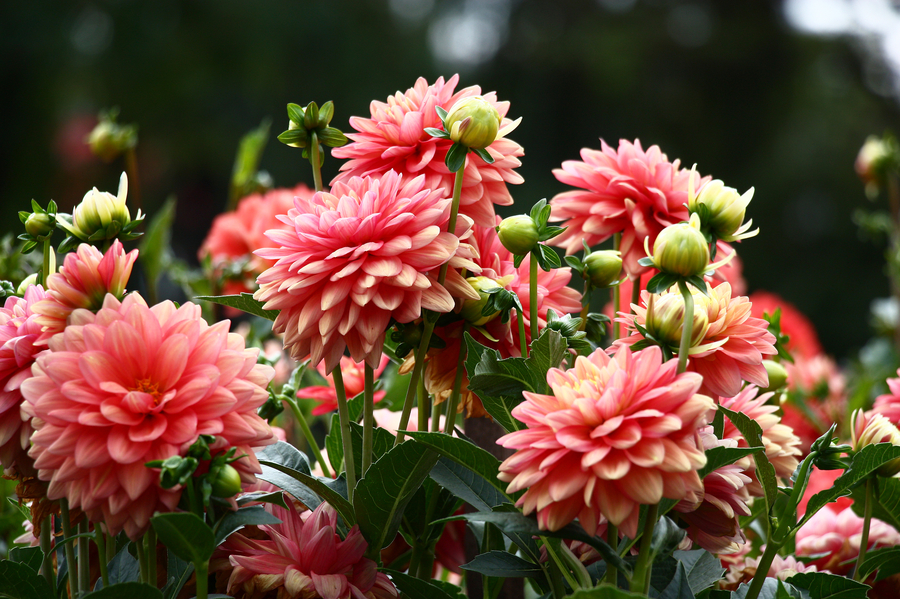
To treat this problem, follow these steps:
- Fertilize dahlias every two to three weeks with high-content phosphorus plant feed and tie the flowering stalks with some support to keep them erect.
- Water once a week from June to August to keep the tubers hydrated.
- Use mulch around the dahlia plant crown to conserve moisture and discourage weed growth.
- Deadhead the spent flowers of your dahlia plants as soon as possible, as it will encourage new bud production and more blooms.
- Use organic and effective slug and snail control products such as Slugo Plus and crushed eggshells to avoid them.
With all these practices, your dahlias will bloom and decorate the garden.
Pruning and Maintenance
Dahlias need regular pruning and maintenance throughout the growing season. The constant pinching of young shoots and buds will promote more bloom production. If you are growing dahlia for cutting, then a weekly pinching of young shoots is beneficial. Also, deadhead the spent flower stalks to promote a longer bloom cycle.
How to Pinch Dahlias
When the growing dahlias are about 1 foot tall, pinch out the 3 to 4 inches of the central, more elevated shoot to encourage more growth of side shoots. This practice will also increase the stem and bloom count for cuttings.
Overwintering Dahlias
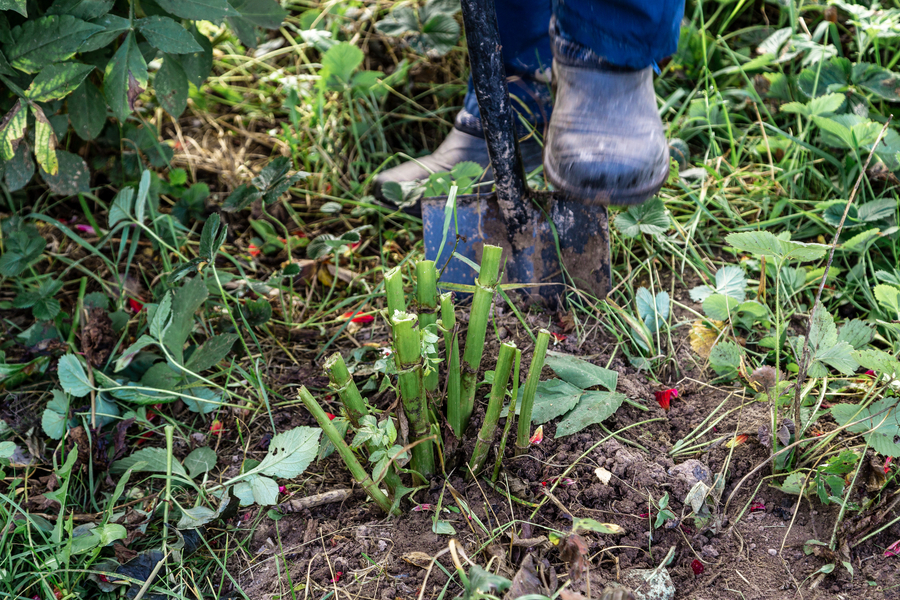
Within their USDA hardiness zone 7 to 10, dahlias tubers can survive the winters and frost when properly mulched and protected. While in more northern regions, it is best to dig up the tubers once they finished blooming and store them in more frost-free areas to overwinter.
When storing the dahlias tubers indoors, follow these tips:
- Dahlia tubers are frost tenders, so dig them up before the severe frost and shake off the excess soil.
- Examine the tubers thoroughly and remove the damaged tuber parts. Also, cut back the stem 5 to 6 inches, then leave the tubers intact for 2 to 3 days.
- Now place the tubers in open boxes, covering them with dry compost or sand.
- Store the tuber boxes in an aerated, cool, and frost-free place. Check them occasionally for rot and cover them with fleece or horticultural sheets during severe cold spells.
Repotting Dahlias
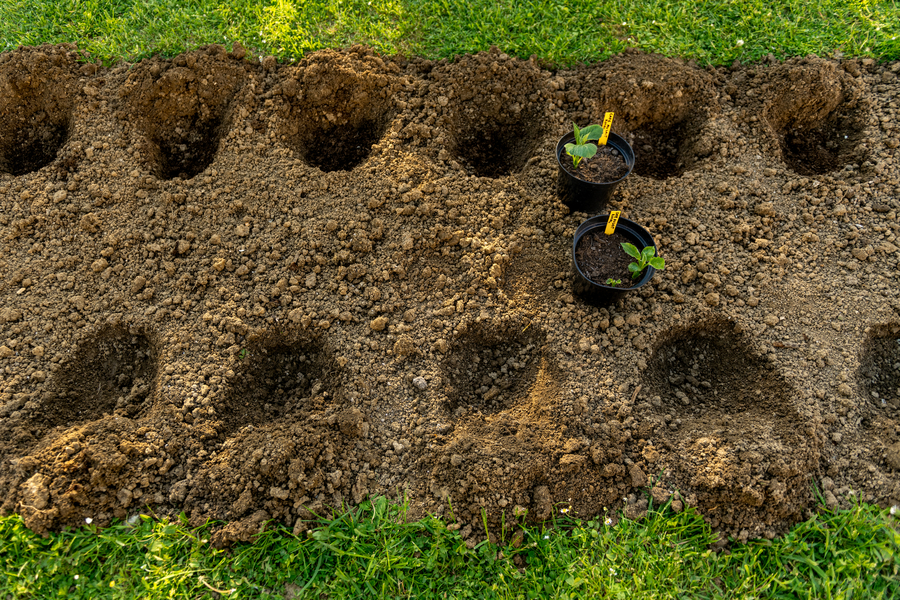
Showy dahlias are grown as flowering annuals in gardens and residential landscapes. However, repotting is unnecessary for container-grown dahlias when planted in a planter 12 inches deep and wide. Bring your container outdoors during summer for plentiful sunlight, pollinators, and fuller blooms.
In addition, one fundamental rule is to stake the taller dahlia varieties to keep them upright and prevent falling during strong winds.
Frequently Asked Questions (FAQ) on How to Take Care of Dahlias
Can dahlias grow in partial shade?
The most important thing you should know in learning how to grow dahlias is that they love the sun. However, in certain areas where the temperature remains above 100°F during summer, dahlias would need partial shade.
This is the opposite in colder areas where you can expose them to as much as sun possible.
What is the best fertilizer for dahlias?
One of the best plant food for dahlias is low nitrogen and high phosphorus feed to balance vegetative and reproductive growth.
The dahlia feeding low in nitrogen supports more reproductive development than foliage and assists the plant in disease escape.
When is it too late to pinch dahlias?
When dahlias grow 24 to 28 inches tall, it is too late to pinch the taller stems. It is recommended to pinch the central shoot when it is around 12 inches tall.
Common Pests and Diseases of Dahlias
These herbaceous perennials are susceptible to many garden insect pests and fungal pathogens. Aphids, earwigs, caterpillars, thrips, slugs, and snails are the most destructive among garden insect pests. These bugs damage the young foliage and impact the dahlia’s photosynthetic activity.
It is necessary to first counter them before you become a master on how to grow dahlias.
Aphids
Aphids are sap-sucking pests that extract plant nutrients from phloem tissues through their piercing-sucking mouthparts. They primarily damage the young leaves, which results in defoliation and stunted growth.
Apply neem oil and insecticidal soap sprays every week from late May till blooming to keep these bugs away from dahlias.
Slugs and Snails
Slugs and snails are also fond of young dahlias and munch on leaf buds. Use Slugo Plus as organic control against these pests or spread crushed eggshells around the plant base to repel them.
Powdery Mildew Disease
This disease appears in dry, hot weather conditions because of less humidity and dry soil conditions. To prevent this disease, keep your dahlias well-watered and maintain higher humidity levels through regular misting.
Earwigs
Earwigs prefer moist, cool conditions like slugs and snails and feed off the young dahlia leaves, and the best way to keep them away is proper garden sanitary practices.
Note: Do not apply harsh chemicals in your garden and onto indoor plants for the control of common insect pests. These harsh chemicals will deter beneficial insects such as ladybugs, green lacewings, and parasitic wasps.
Image credit: Depositphotos
